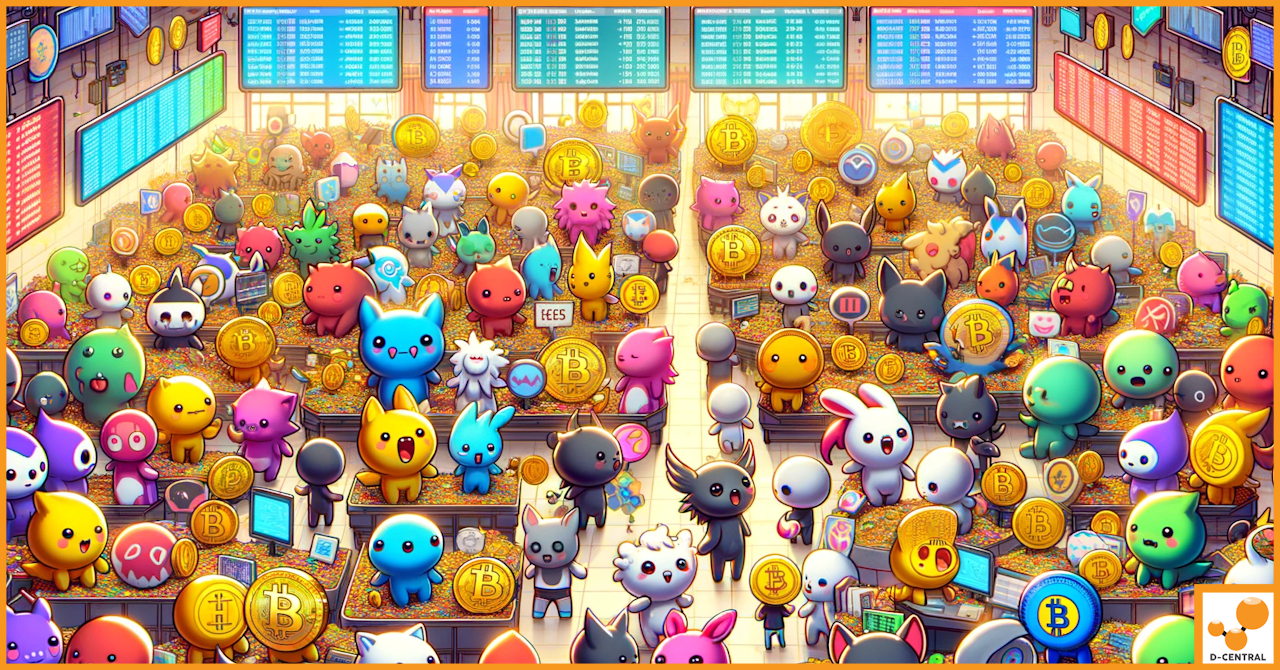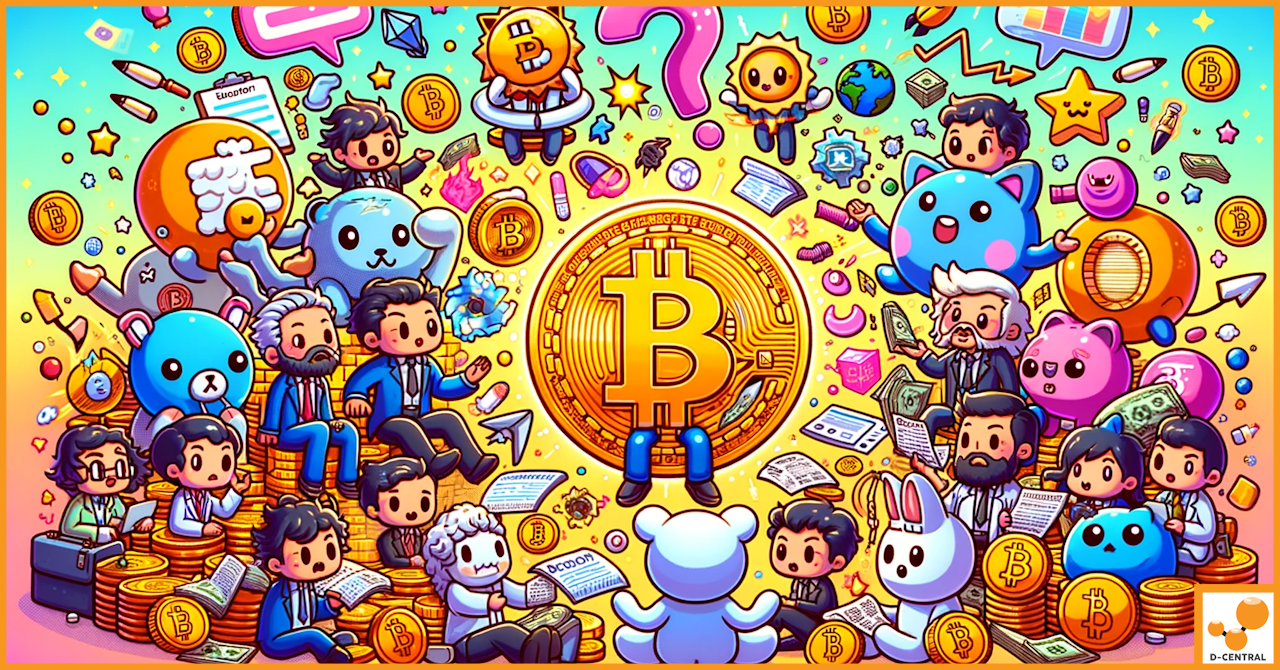
How Printing Facilities Can Leverage Bitcoin Mining Heat for Extra Revenue
Printing facilities are increasingly turning to Bitcoin mining operations as a way to improve operational efficiency and generate additional income.
4479 Desserte Nord Autoroute 440, Laval, QC H7P 6E2

In the ever-evolving world of digital finance, cryptocurrency exchanges have emerged as pivotal players, shaping the way we buy, sell, and perceive digital assets. These platforms, ranging from renowned giants to emerging contenders, offer a gateway to the dynamic and often perplexing realm of cryptocurrencies. Amidst a plethora of digital currencies, a particular category known as “shitcoins” has garnered both intrigue and skepticism within the crypto community.
Shitcoins, typically characterized by their lack of intrinsic value, unclear development goals, or absence of a substantial user base, often stir debates regarding their legitimacy and potential. These coins, sometimes born out of memes or as speculative ventures, lack the robust framework or innovative utility found in more established cryptocurrencies like Bitcoin or Ethereum. Despite these shortcomings, shitcoins continue to find a place on various cryptocurrency exchanges, leading many to question the rationale behind their listings.
The purpose of this article is to unravel the complexities behind why exchanges list an abundance of these so-called shitcoins. By delving into the economic incentives for exchanges, the psychology of investors flocking to these assets, and the criteria used by exchanges to vet new listings, we aim to provide clarity and guidance for investors navigating this often murky segment of the cryptocurrency market. Our goal is not only to demystify the presence of shitcoins on exchanges but also to empower investors with the knowledge to make informed decisions in their crypto ventures.
Cryptocurrency exchanges, the bustling marketplaces of the digital asset world, are often seen as the gatekeepers of which coins gain exposure and traction. Among the myriad of cryptocurrencies they list, shitcoins – despite their often dubious reputation – hold a unique allure for these platforms. This attraction can be primarily attributed to two key factors: financial incentives and market dynamics.
Financial Incentives
Discussion on Listing Fees, Transaction Fees, and Other Revenue Sources for Exchanges:
One of the primary motivators for exchanges to list a wide variety of cryptocurrencies, including shitcoins, is the financial benefit. Listing fees represent a significant revenue stream for these platforms. When a new coin seeks to be listed, exchanges often charge a substantial fee, which can vary widely based on the exchange’s stature and the perceived value of the coin. These fees can range from a few thousand to several hundred thousand dollars, providing a lucrative income for the exchanges.
Beyond the initial listing fees, exchanges also benefit from transaction fees. Every trade executed on the platform incurs a small charge, typically a percentage of the trade value. While these fees are usually minimal on a per-transaction basis, they accumulate to substantial amounts due to the high volume of trades, especially when a new coin generates significant interest and activity.
Moreover, exchanges may derive revenue from other sources related to new listings, such as promotional activities, advertising, and premium features offered to traders. The introduction of a new, potentially popular shitcoin can enhance user engagement and increase overall platform usage, leading to higher revenues from these ancillary services.
Analysis of How New Listings Boost User Traffic and Trading Volume:
The listing of new cryptocurrencies, including those labeled as shitcoins, often creates a buzz in the crypto community, attracting both seasoned and novice traders. This surge in interest leads to increased user traffic on the exchange, as traders flock to the platform to buy, sell, or simply speculate on these new assets. The heightened activity not only boosts trading volume but also enhances the exchange’s visibility and reputation in the market.
Market Dynamics
Exploration of Market Demand for Diverse Cryptocurrencies:
The cryptocurrency market is characterized by its diversity and the continuous appetite of investors for new and varied assets. Traders and investors are often on the lookout for the next big coin, driven by the desire to discover undervalued assets that could yield high returns. This quest for diversity and potential gains fuels the demand for a wide range of cryptocurrencies, including shitcoins, which are often perceived as hidden gems with untapped potential.
The Role of Exchanges in Enhancing Liquidity and Visibility of New Coins:
Exchanges play a crucial role in enhancing the liquidity of new cryptocurrencies. By listing these coins, they provide a platform for these assets to be traded, thereby facilitating liquidity. This is particularly important for lesser-known coins, which might otherwise struggle to find a market. The increased liquidity not only benefits traders who can buy and sell these assets more easily but also aids in establishing a market price for the coins.
Furthermore, exchanges contribute significantly to the visibility and credibility of new cryptocurrencies. Being listed on a reputable exchange can be seen as a stamp of approval or a sign of legitimacy for a new coin. This perceived endorsement can be particularly valuable for shitcoins, which might otherwise be overlooked or dismissed due to their inherent risks and speculative nature.
The listing of shitcoins on exchanges is driven by a combination of financial incentives for the exchanges and the dynamic demands of the cryptocurrency market. While these listings offer opportunities for traders and provide liquidity and visibility for new coins, they also underscore the need for cautious and informed trading strategies in the volatile world of cryptocurrencies.
The cryptocurrency market, with its high volatility and potential for significant returns, has a unique appeal, particularly when it comes to the allure of shitcoins. Understanding the psychology behind investor attraction to these high-risk assets is crucial for navigating the crypto landscape.
The Lure of Quick Profits
Examination of the Psychological Factors Driving Investors Towards Shitcoins:
The primary psychological driver luring investors towards shitcoins is the prospect of quick and substantial profits. This phenomenon, often termed as the “get-rich-quick” mentality, is prevalent in the cryptocurrency space. Investors, especially those new to the market or those who have witnessed others making substantial gains, are often drawn to the promise of similar returns. The volatility of shitcoins, while risky, presents an opportunity for massive gains in a short period, a prospect that can be irresistibly enticing.
Another psychological factor is the fear of missing out (FOMO). As investors see others profiting from early investments in unknown or little-known cryptocurrencies, they fear missing out on potential gains. This fear can lead to impulsive investment decisions without proper due diligence.
The Role of Marketing and Hype
Analysis of Marketing Strategies Used by Shitcoin Creators:
Shitcoin creators often employ aggressive marketing strategies to attract investors. These strategies can include overstated claims about the coin’s potential, partnerships, or technological capabilities. Marketing campaigns are designed to create a sense of urgency and scarcity, suggesting that early investment will lead to higher returns.
Another common tactic is the use of technical jargon or complex whitepapers that give an illusion of legitimacy and innovation, even when the actual product offers no real value or differentiation in the market.
The Impact of Social Media and Influencer Endorsements:
Social media and influencer endorsements play a significant role in the hype surrounding shitcoins. Influencers, often with large followings on platforms like Twitter, YouTube, or Instagram, can sway market sentiment by promoting certain coins, sometimes without disclosing financial incentives.
These endorsements can lead to rapid spikes in investment from followers who trust the influencer’s judgment. However, this trust can be misplaced, as influencers may not have the expertise to evaluate the viability of the cryptocurrency, or they might be motivated by personal gain rather than the interests of their audience.
In conclusion, the psychology behind the attraction to shitcoins is multifaceted, driven by the lure of quick profits, the fear of missing out, and the influence of aggressive marketing and social media hype. Investors should approach these assets with caution, recognizing the role of psychological biases and the potential for manipulation in the market.
The process of listing a new coin on a cryptocurrency exchange is intricate and multifaceted. Exchanges meticulously evaluate various aspects of a coin before deciding to list it, ensuring that it meets their standards and aligns with their strategic objectives. This evaluation process is crucial in maintaining the exchange’s credibility and protecting the interests of its users.
Evaluating New Coins
Overview of Factors Considered by Exchanges: Coin Structure, Team Credentials, Community Strength, and Use Case:
Insights from Industry Experts on Listing Criteria:
Industry experts emphasize the importance of transparency and regulatory compliance in the listing process. They advise exchanges to conduct rigorous due diligence, including legal checks, to ensure that the coins comply with relevant laws and regulations. Experts also suggest that exchanges should consider the long-term viability and economic model of the coin, rather than just the hype or current market trends.
The Balancing Act
Discussion on the Balance Between Innovation, Opportunity, and Risk Management by Exchanges:
Cryptocurrency exchanges face the challenging task of balancing innovation and opportunity with risk management. On one hand, they aim to offer a diverse range of innovative coins to attract traders and stay competitive. On the other hand, they must manage the risks associated with listing new and untested coins, which can include regulatory risks, market manipulation, and the potential for scams.
Exchanges employ various strategies to strike this balance, such as implementing phased listing processes, where a coin is initially listed with limited functionality and monitored for stability before full trading is enabled. They also establish strict listing criteria and continuously monitor listed coins for compliance with these standards.
Furthermore, exchanges are increasingly engaging with regulatory bodies and adopting best practices to navigate the evolving regulatory landscape. By doing so, they aim to protect their users and maintain the integrity of their platforms, while still fostering a dynamic and innovative trading environment.
In conclusion, the criteria for exchange listings involve a comprehensive evaluation of a coin’s technical structure, the credibility of its team, the strength of its community, and the viability of its use case. Exchanges must carefully balance the pursuit of innovation and opportunity with effective risk management to ensure the safety and integrity of their platforms.
Investing in shitcoins, often characterized by their lack of intrinsic value and uncertain future, carries significant risks. While the allure of high returns can be tempting, it’s crucial for investors to understand and recognize the potential pitfalls associated with these types of investments.
Understanding the Risks
Detailed Analysis of the Risks Associated with Investing in Shitcoins
Real-Life Examples of Significant Losses and Scams:
Spotting Red Flags
Tips on Identifying Scamcoins and Avoiding Fraudulent Investments
By understanding the risks and learning to spot the red flags, investors can navigate the treacherous waters of shitcoin investments with greater caution and discernment. While the potential for high returns exists, the risks are equally significant, and a cautious approach is paramount in these speculative markets.
In the volatile and often unpredictable world of cryptocurrency, adopting a rational and informed approach to investment is crucial. This approach not only mitigates risks but also aligns with long-term investment goals and market realities.
D-Central’s Perspective
D-Central’s Advocacy for Informed and Cautious Investment Strategies:
D-Central Technologies, a leader in the Bitcoin mining landscape, strongly advocates for an informed and cautious approach to cryptocurrency investments. Understanding the complexities of the market, D-Central emphasizes the importance of thorough research and due diligence before diving into any crypto investment, especially in lesser-known coins.
The company advises investors to look beyond the hype and evaluate cryptocurrencies based on their technological merits, market potential, and the credibility of the teams behind them. This approach helps in distinguishing viable long-term investments from fleeting speculative opportunities.
Highlighting the Stability and Potential of Established Cryptocurrencies like Bitcoin:
D-Central places a significant focus on the stability and growth potential of established cryptocurrencies, particularly Bitcoin. As a Bitcoin Maximalist entity, D-Central recognizes Bitcoin’s pioneering role in the cryptocurrency space and its continued relevance as a digital asset.
Bitcoin’s robust blockchain technology, widespread adoption, and growing acceptance as a store of value and medium of exchange underscore its stability compared to newer, more speculative cryptocurrencies. D-Central encourages investors to consider Bitcoin as a cornerstone of their crypto investment portfolios, given its proven track record and potential for sustained growth.
Educating the Crypto Community
D-Central’s Role in Providing Resources and Guidance for Safe Cryptocurrency Investments:
D-Central is committed to educating the crypto community, offering resources and guidance to both novice and experienced investors. This commitment is reflected in their efforts to provide clear, accurate, and up-to-date information about the crypto market and investment strategies.
Through various platforms, including their website, social media channels, and educational seminars, D-Central shares insights on market trends, investment risks, and the latest developments in the cryptocurrency space. They aim to empower investors with the knowledge needed to make informed decisions, navigate the market’s complexities, and avoid common pitfalls.
Additionally, D-Central’s expertise in Bitcoin mining and ASIC repairs provides a practical perspective on the operational aspects of the crypto world, further enriching their educational offerings.
In summary, D-Central’s approach to cryptocurrency investments is characterized by a blend of caution, informed decision-making, and a focus on established digital assets like Bitcoin. By educating the crypto community and advocating for a rational investment strategy, D-Central contributes to a more informed and responsible crypto investment landscape.
The cryptocurrency landscape, with its myriad of offerings and opportunities, presents a complex and often challenging environment for investors. This complexity is particularly evident in the realm of shitcoin listings on exchanges, where the allure of high returns is frequently shadowed by significant risks and volatility. As we have explored, the reasons behind these listings are multifaceted, encompassing financial incentives for exchanges, investor psychology, and market dynamics.
The key takeaway for investors is the paramount importance of due diligence and informed decision-making. Navigating the crypto market requires a discerning eye, a deep understanding of the underlying technologies, and an awareness of the market’s speculative nature. It is crucial to approach cryptocurrency investments with a balanced perspective, recognizing both the potential rewards and the inherent risks.
D-Central Technologies, as a leader in the Bitcoin mining industry and a proponent of informed cryptocurrency practices, offers a wealth of resources and guidance for those looking to deepen their understanding of the crypto market. We encourage readers to leverage these resources to build a solid foundation of knowledge and to approach their crypto investments with confidence and insight.
For those seeking to engage more deeply in the world of cryptocurrency, D-Central offers a range of services and products designed to support secure and knowledgeable investment strategies. From consultation services that provide personalized advice, to a selection of high-quality mining hardware, D-Central is equipped to assist both new and seasoned investors in their crypto journey.
We invite you to explore D-Central’s offerings and take advantage of their expertise in the field. Whether you are looking to start mining, seeking advice on investment strategies, or simply wish to stay informed about the latest developments in the crypto world, D-Central is your go-to resource.
For more information and to explore D-Central’s services, visit their website and connect with their team of experts. Let D-Central be your guide in the dynamic and exciting world of cryptocurrency investment.
What are “shitcoins”?
Shitcoins are typically characterized by their lack of intrinsic value, unclear development goals, or absence of a substantial user base. They often lack the robust framework or innovative utility found in more established cryptocurrencies.
Why do exchanges list shitcoins?
Exchanges list shitcoins for several reasons, including financial incentives such as listing fees and transaction fees, the dynamic demands of the cryptocurrency market, and to enhance their platform’s liquidity and visibility.
What attracts investors to shitcoins?
Investors are often lured to shitcoins by the prospect of quick and substantial profits, driven by factors like the “get-rich-quick” mentality and the fear of missing out (FOMO), as well as aggressive marketing strategies and social media hype.
What criteria do exchanges use to list new coins?
Exchanges evaluate various aspects before listing a new coin, including its technical structure, the team’s credentials, community strength, and the coin’s use case. They balance innovation, opportunity, and risk management.
What are the risks associated with investing in shitcoins?
Risks include extreme volatility, market manipulation, lack of liquidity, potential involvement in fraudulent projects, and regulatory risks. High-profile scams have included Bitconnect and the Squid Game Token scam.
How can investors identify scam-coins and avoid fraudulent investments?
Investors should conduct thorough research, check for transparency, be wary of unrealistic promises, monitor community and social media activity, and be cautious of coins relying heavily on celebrity endorsements.
What is D-Central’s perspective on cryptocurrency investments?
D-Central advocates for an informed and cautious approach to cryptocurrency investments, emphasizing the importance of thorough research and due diligence. The company focuses on the stability and potential of established cryptocurrencies like Bitcoin and provides resources and guidance for safe investments.
DISCLAIMER: D-Central Technologies and its associated content, including this blog, do not serve as financial advisors or official investment advisors. The insights and opinions shared here or by any guests featured in our content are provided purely for informational and educational purposes. Such communications should not be interpreted as financial, investment, legal, tax, or any form of specific advice. We are committed to advancing the knowledge and understanding of Bitcoin and its potential impact on society. However, we urge our community to proceed with caution and informed judgment in all related endeavors.
Related Posts

Printing facilities are increasingly turning to Bitcoin mining operations as a way to improve operational efficiency and generate additional income.

In the ever-evolving landscape of digital currencies, Bitcoin stands as a pioneering force, a symbol of innovation and a barometer

In the dynamic world of cryptocurrency, rumors often spark as much conversation as confirmed news. One such rumor that has